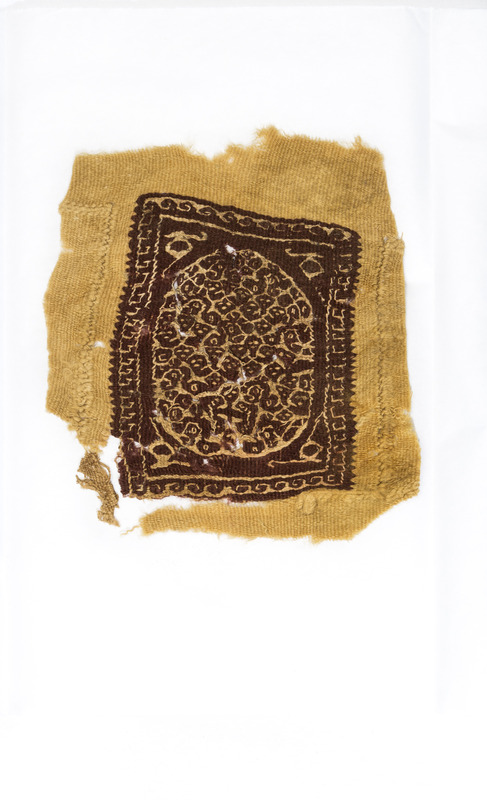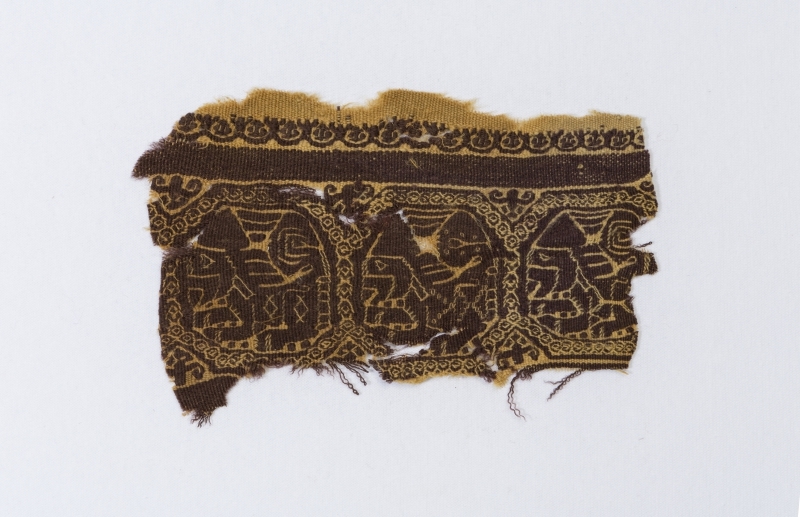Other
Figure 1 features three highly stylized figures in a line seen from the side. Each figure is surrounded by a pattern of knots, which is a protective motif and is very similar. The only significant difference is the pattern appearing on each figure’s hind legs and tails. The figures have the same head that appears to be human. Either a beard and a cap or a mane surrounds the figures’ heads. The figures appear to be in a crouching position on four legs (all of which are visible), while parallel lines above each figure may depict wings. Each figure may be a lion or some type of mythical creature like a sphinx, but the extreme stylization makes determining the creature that the creator intended to depict very difficult. It is also difficult to determine the reason each figure varies slightly, as this could be either a stylistic decision or an intentional mix of symbolic meaning. Damage to the fragment also makes determining the type of textile it may have come from very difficult.
The pattern in the center of Figure 2 is highly stylized and extremely damaged. It may simply be a vegetal motif in which each small circle represents part of a vine. Round vegetal motifs tend to be accompanied by a vase from which the vines are sprouting, but in this instance a vase does not appear to be present. Another possibility is that the pattern is intended to represent a Tree of Life, which was a popular symbol of fertility and good fortune through the Late Antique period and into the Byzantine period when it was assimilated as a Christian symbol. If this was intended to be a Tree of Life, the straight sections of pattern would represent the branches and trunk of the tree and the circular sections would represent leaves.
Figure 3 features a pair of bands running parallel to each other with the same images on each band. Pairs of decorative bands are commonly part of the sleeves of tunics, though this fragment could have come from a furnishing textile or a different garment. The images in each band are difficult to interpret, but each band seems to feature two separate motifs. The motif on the top is dyed several colors and may represent a vegetal motif in a flowering plant is growing out of a vase. The flowers are dyed red. The vase is in the center of the motif and is round at the bottom. The motif on the bottom is less clear. It may represent another vegetal motif, perhaps a bisected fruit or poppy bud.
REFERENCES
Du Bourguet, Pierre M. Art of the Copts. New York: Crown Publishers, Inc., 1967.
Friedman, Florence D. Beyond the Pharoahs: Egypt and the Copts in the 2nd and 7th Centuries A.D. Providence, Rhode Island: Rhode Island School of Design Museum of Art, 1989.
Kybalová, Ludmila. Coptic Textiles. Translated by Till Gottheiner. London: Drury House, 1967.
Maguire, Eunice Dauterman, Maguire, Henry P., and Duncan-Flowers, Maggie J. Art and Holy Powers in the Early Christian House. Urbana and Chicago: University of Illinois Press, 1989.
Noever, Peter. Fragile Remnants: Egyptian Textiles of Late Antiquity and Early Islam. Translated by Abigail Ryan-Prohaska. Los Angeles: Schindler House, 2005.
Pollitt, J.J. Art of the Hellenistic Age. New York: Cambridge University Press, 1987.
Rutschow, Marie-Hélène. Coptic Fabrics. Translated by Adam Stephenson, Susan Ashcroft, Victoria Erbin, Patricia Kessler, and Thomas Kessler. Paris: Editions Adam Biro, 1990.
Thomas, Thelma K. Designing Identity: The Power of Textiles in Late Antiquity. Princeton and Oxford: Princeton University Press, 2016.
Wessel, Klaus. Coptic Art. London: Thames and Hudson, 1965.


